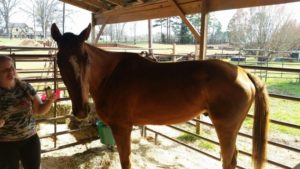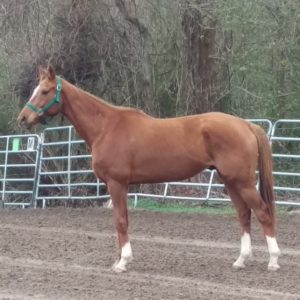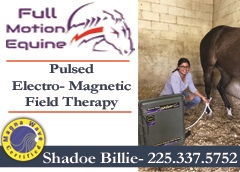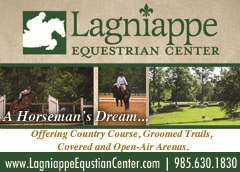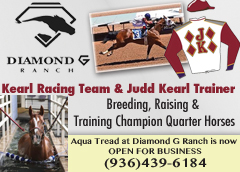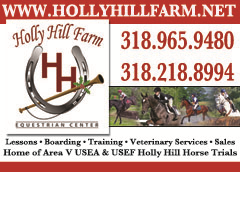By Emily McAtee.
[Emily McAtee continues her journey with Champagne, her “Retired Racehorse Project.” Her goal is to compete with him in the Thoroughbred Makeover, October 5 – 8, 2017, at the Kentucky Horse Park. Visit https://www.retired racehorseproject.org/2017-thoroughbred-makeover for schedule, tickets, and profiles of all the trainers and their horses.]
A little while ago I was bragging to someone about how much progress my little Retired Racehorse Project horse was making and how proud I was of him. And then this person asked what I’ve done with him so far, and my answer was so spectacularly profound, thoughtful, and clearly inspired by that moment that I still clearly remember exactly what I said.
“Eeeeerrrrgh.”
Fortunately, we changed the subject right after that.
But this bothered me. After a month of work I knew that Champagne had made a lot of positive changes, but trying to put them into words made them seem absolutely insignificant. Unlike the progress of many of the RRP trainers I see who are already taking their horses to competitions, my successes seem small in comparison. What was I supposed to say? “I taught my horse how to trot!” “He’s learned to let me touch his ears!” “We walked around the arena today and didn’t die!” They seem so insignificant compared to the things that other trainers are doing. I’m not doing flying lead changes or half passes or jumping or cutting cattle or anything so big and flashy and praiseworthy. There are plenty of days when I’m lucky to work with Champagne at all. But after a few weeks of feeling ridiculous, I finally remembered something.
This is my journey. I’m not a professional with a $4000 horse training a world class jumper. I’m an amateur taking a $500 Rescued OTTB with all kinds of physical and emotional baggage and rehabilitating him. I’m using whatever knowledge and skills I’ve managed to acquire to give Champagne a life that doesn’t end at the kill pen. Champagne and I are genuinely doing our best, and to pretend that we should somehow be giving more would be doing us both a disservice.
So now we’re at about week 10 of our training (22 weeks to go!), and I can give a much clearer answer about the changes that we’ve made.
Training
In terms of traditional training, I started with a horse that could be groomed and saddled and bridled and walk and gallop in a straight line. In all fairness, it’s not a bad place to start. Now I have a horse who can
- Quietly allow a rider to mount (not his strong suit starting out)
- Walk, trot, canter, and halt calmly according to my aids on the lunge line
- Walk, trot, sidepass, back, do turns on the forehand and haunches, and perform some beginning lateral work
- Hack out solo
- Ride in groups without being absolutely convinced that he must race the rest of the horses
Physical Fitness
Teaching a horse a particular set of movements is easy. Teaching a horse to perform those movements athletically and correctly is an entirely different story. The movements can be learned in a pretty short time. Athleticism can take years to develop, and training a horse to carry him/herself correctly is a work of art. This has been a lot of the emphasis of our training (which is why Champagne and I haven’t even started cantering under saddle- he’s not quite strong enough yet). Coupled with good nutrition, a much needed visit from the equine dentist, and massage therapy (just what I can do myself- I dream on a budget, remember), the changes in just two months have been phenomenal.
When I first got him, Champagne had horribly tight hamstrings and his poll was essentially locked into one position. Trying to ride him was like trying to maneuver box springs up three flights of stairs and through two narrow doorways set at different angles. He would be heavy on the forehand, pull you forward with the reins, and absolutely gnaw on the bit, which was impressive considering how high he usually carried his head. On the rare occasion that he did bend his neck, it wasn’t a nice, pretty curve. It was three jagged lines dispersed somewhere between his head and his shoulders. He absolutely could run for a good long while (not because I asked, mind you), but a half hour walk/trot lunge session over poles would be absolutely exhausting. I had to focus on stretching and strengthening and developing his musculoskeletal structure if I wanted to even have a rideable horse, let alone one I could ever hope to take to a competition.
Now Champagne
- listens first to my seat, not my hands
- moves quietly off of my legs
- seeks contact, but no longer braces
- is supple
- is quick on the aids
- can stretch
- is starting to lift his back
- can lengthen or shorten his gaits somewhat
- is significantly more balanced
- has developed flexibility in the poll and hamstrings
And of course, in terms of what it’s done for him physically, well, the lighting isn’t good, but take a look.
Week 1
Week 8
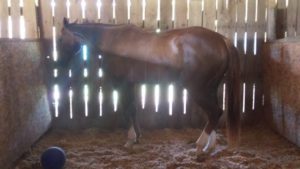
I think that Champagne looks much less like a stick horse and much more like the real thing, and my boss no longer cringes when she looks at him. I think he might even be slightly less cowhocked than before, but that might be wishful thinking. There’s still plenty to be done, but I think that’s a pretty good start.
Emotional Health
One of the most common things I hear about horses is that they have about the mentalities of two year old children. They don’t really know how to lie yet, they poop everywhere, everything goes into their mouth, and when there’s something they want, they can be surprisingly creative about how to get it. And just like two year old children, I think it’s important to nurture healthy relationship skills with our training horses.
Champagne is a bit of a timid soul and not particularly inclined to express himself. As a matter of fact, when he first came in, I’m not entirely certain that he actually knew how to express himself. One of the first days I had him I brought him inside and had him in the cross ties for grooming. We had some kids around the barn, and as soon as a new horse appeared, they were instantly fascinated and everyone wanted to come and pet his face and be his friend. Champagne was still for a few minutes, and I thought he was okay. Then suddenly he freaked out, pulled backwards, and slipped right out of the halter and ran to the back of the barn to hide. Amanda herded all of the kids away and I herded my horse back to his stall, shaking my head at this disaster and thanking the powers that be that it wasn’t worse.
Fortunately, I at least knew that he wasn’t trying to be naughty or mean. All of those kids with all of their crazy kid energy freaked him out, and he was suffering from what I can only describe as “Stranger Danger.” He had never learned to express his discomfort quietly, like a toddler turning his head away from a new person and hiding behind his mom. Champagne had learned to bottle it up until it was too much for him, and then when he had passed his stress threshold, he exploded and ran. Essentially, he skipped right past “I can’t see you, you can’t see me” straight to screaming “Stop, Stranger, Stay AWAY!” and there wasn’t much I could do about it.
So essentially, I had to start this whole “human interaction” thing all over. For about a week or two, I just groomed him. That was it. I groomed him and I watched very carefully for any social cues telling me what he was feeling, and as soon as I saw them, I responded. It was extraordinary, because I don’t think that he was even aware of the signals he had been sending. Obviously I don’t know for certain, but I can only guess that no one had ever really listened to those signals, so he stopped using them. Most likely he had been ignored up until he acted “naughty” and then punished for his naughty behavior. (Just to be clear, I’m not accusing anyone of abuse: I think that someone was probably a little too goal oriented about getting him on the racetrack. It’s an easy enough mistake to make, and one I am inclined to make myself.) But here I was, retraining him to know that I was hearing him, and I would do my best to do right by him. Basically, my goal was to remind him that he had a voice in this conversation too.
Here’s how I know that we made progress. Fast forward to week 9, and once again, he and I are working together while there are some kids nearby. Some of them ask me if they can pet him, and I say “Sure, fine by me.” Instantly, he’s swarmed by three at once. He pulls his face away and looks at me, feeling a little bit panicked. I stop the girls and start again. “If you want to pet him, you can try, but you should probably go one at a time and ask his permission first. Try holding out your hand and letting him smell you. If he doesn’t pull away, you can pet him. If he does, respect his space and maybe ask him again later.” (He’s not mouthy or treat-sour, so I trust him to not nip anyone. If he was, I wouldn’t suggest holding out hands.) It was wonderful to watch, for two reasons. The first was that he used a quieter behavior to display his discomfort. The second was that after I told them to ask for his permission first, the way the girls approached him changed instantly. He was no longer a curiosity to pet and snuggle, like a new stuffed animal. These girls suddenly approached him as an individual being with his own unique personality that needed to be respected. Looking back on it, I can’t help but cheer a little bit for that small, seemingly insignificant moment. But three girls started to learn how important it can be to listen when it would be easier to speak, and a horse learned that someone else besides his trainer was listening too.
Of course, with all of these areas, Champagne and I have a long way to go. Obviously there is more to learn (like canter departs, for one), more ways to strengthen and improve (more lateral work and pole work wouldn’t go amiss), and more things to talk about (he’s starting to tell me what he doesn’t like; now I’d like to find out more about what he does like). But if he improves at even half the rate that he has, I’ll be ecstatic. Meanwhile, I think I’ll learn to savor the small changes. They are pretty sweet.

